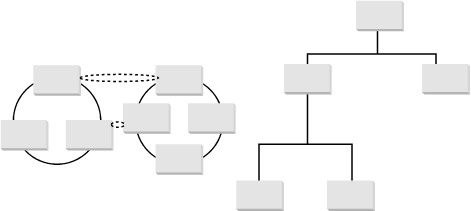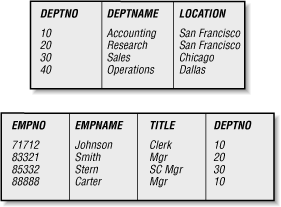Where do we start? One of the problems in comprehending a massive product such as the Oracle database is the difficulty of getting a good sense of how the product works without getting lost in the details of implementing specific solutions. This book aims to solve this problem by giving you a thorough grounding in the concepts and technologies that form the foundation of Oracle’s technology products: the Database Server (currently Oracle9i) and the Application Server (Oracle9iAS). Oracle is also a provider of business applications, popularly named the “E-Business Suite”; discussion of those applications is outside the scope of this book, although we do touch on how technology components are being leveraged in linking Oracle’s applications to non-Oracle applications and in building data warehouses.
We’ve tried to write a book for a wide range of Oracle users, from the novice to the experienced user. To address this range of users, we’ve focused on the concepts and technology behind the Oracle database. Once you fully understand these facets of the product, you’ll be able to handle the particulars of virtually any type of Oracle database. Without this understanding, you may feel overburdened as you try to connect the dots of Oracle’s voluminous feature set and documentation.
This first chapter lays the groundwork for the rest of the discussions in this book. Of all the chapters, it covers the broadest range of topics; most of these are discussed further later in the book, but some of the basics—for example, the brief history of Oracle and the contents of the different “flavors” of the Oracle database products—are unique to this chapter.
Oracle has grown from its humble beginnings as one of a number of databases available in the 1970s to the overwhelming market leader of today. In its early days, Oracle Corporation was known as an aggressive sales and promotion organization. Over the years, the Oracle database has grown in depth and quality, and its technical capabilities now match its early hype. With the Oracle8, Oracle8i, and Oracle9i releases, Oracle has added more power and features to its already solid base.
Oracle8, released in 1997, added a host of features (such as the ability to create and store complete objects in the database) and dramatically improved the performance and scalability of the database. Oracle8i, released in 1999, added a new twist to the Oracle database—a combination of enhancements that made the Oracle8i database the focal point of the new world of Internet computing. Oracle9i adds an advanced version of Oracle Parallel Server named Real Application Clusters, along with many additional self-tuning, management, and data warehousing features.
Before we dive into the specific foundations of these new releases, we must spend a little time describing some Oracle basics—how databases evolved to arrive at the relational model, a brief history of Oracle Corporation, and an introduction to the basic features and configurations of the database.
The concept of the relational database was first described around 1970 by Dr. Edgar F. Codd in an IBM research publication entitled “System R4 Relational.” Initially, it was unclear whether any system based on these concepts could achieve commercial success. Nevertheless, Relational Software, Incorporated (RSI) was founded in 1979 and released Oracle V.2 as the world’s first relational database. By 1985, Oracle could claim more than 1,000 relational database customer sites. IBM itself would not embrace relational technology in a commercial product until the Query Management Facility in 1983.
Why has relational database technology grown to become the de facto database technology since that time? A look back at previous database technology may help to explain this phenomenon.
Database management systems were first defined in the 1960s to provide a common organizational framework for what had been data stored in independent files. In 1964, Charles Bachman of General Electric proposed a network model with data records linked together, forming intersecting sets of data, as shown on the left in Figure 1-1. This work formed the basis of the Codasyl Data Base Task Group. Meanwhile, the North American Aviation’s Space Division and IBM developed a second approach based on a hierarchical model in 1965. In this model, data is represented as tree structures in a hierarchy of records, as shown on the right in Figure 1-1. IBM’s product based on this model was brought to market in 1969 as the Information Management System (IMS). As recently as 1980, almost all database implementations used either the network or hierarchical approach. Although several competitors utilized these technologies, only IMS remains.
The relational database uses the concept of linked two-dimensional tables consisting of rows and columns, as shown in Figure 1-2. Unlike the hierarchical approach, no predetermined relationship exists between distinct tables. This means that the data needed to link together the different areas of the network or hierarchical model need not be defined. And because relational users don’t need to understand the representation of data in storage to retrieve it (many such users created ad hoc queries against the data), ease of use helped popularize the relational model.
Relational programming is nonprocedural and operates on a set of rows at a time. In a master-detail relationship between tables, there can be one or many detail rows for each individual master row, yet the statements used to access, insert, or modify the data would simply describe the set of results. In many early relational databases, data access required the use of procedural languages that worked one record at a time. Because of this set orientation, programs can access relational databases more easily.
The contents of the rows in Figure 1-2 are sometimes referred to as records. A column within a row is referred to as a field. Tables are stored in a database schema, which is a logical organizational unit within the database. Other logical structures in the schema often include the following:
- Views
Provide a single view of data derived from one or more tables or views. The view is an alternative interface to the data, which is stored in the underlying table(s) that make up the view.
- Sequences
Provide unique numbers for column values.
- Stored procedures
Contain logical modules that can be called from programs.
- Synonyms
Provide an alternative name for database objects.
- Indexes
Provide faster access to table rows.
- Database links
Provide links between distributed databases.
The relationships between columns in different tables are typically described through the use of keys , which are implemented through referential integrity constraints and their supporting indexes. For example, in Figure 1-2, you can establish a link between the DEPTNO column in the second table, which is called a foreign key , to the DEPTNO column in the first table, which is referred to as the primary key of that table.
Finally, even if you define many different indexes for a table, you don’t have to understand them or manage the data they contain. Oracle includes a query optimizer that chooses the best way to use your indexes to access the data for any particular query.
The relational approach lent itself to the Structured Query Language (SQL). SQL was initially defined over a period of years by IBM Research, but it was Oracle Corporation that first introduced it to the market in 1979. SQL was noteworthy at the time for being the only language needed to use relational databases, because you could use SQL:
For queries (using a SELECT statement)
As a Data Manipulation Language or DML (using INSERT, UPDATE, and DELETE statements)
As a Data Definition Language or DDL (using CREATE or DROP statements when adding or deleting tables)
To set privileges for users or groups (using GRANT or REVOKE statements)
Today, SQL contains many extensions with ANSI/ISO standards that define its basic syntax.
In 1983, RSI was renamed Oracle Corporation to avoid confusion with a competitor named RTI. At this time, the developers made a critical decision to create a portable version of Oracle (Version 3) that ran not only on Digital VAX/VMS systems, but also on Unix and other platforms. By 1985, Oracle claimed the ability to run on more than 30 platforms (it runs on more than 70 today). Some of these platforms are historical curiosities today, but others remain in use. (In addition to VMS, early operating systems supported by Oracle included IBM MVS, DEC Ultrix, HP/UX, IBM AIX, and Sun’s Solaris version of Unix.) Oracle was able to leverage and accelerate the growth of minicomputers and Unix servers in the 1980s. Today, Oracle leverages its portability on Microsoft Windows NT/2000 and Linux to capture a significant market share on these more recent platforms.
In addition to multiple platform support, other core Oracle messages from the mid-1980s still ring true today, including complementary software development and decision support tools, ANSI standard SQL and portability across platforms, and connectivity over standard networks. Since the mid-1980s, the database deployment model has evolved from dedicated database application servers to client/server to Internet computing implemented with PCs and thin clients accessing database applications via browsers.
Oracle introduced many innovative technical features to the database as computing and deployment models changed (from offering the first distributed database to the first Java Virtual Machine in the core database engine). Table 1-1 presents a short list of Oracle’s major feature introductions.
Table 1-1. History of Oracle Technology Introductions
Get Oracle Essentials: Oracle9i, Oracle8i and Oracle8, Second Edition now with the O’Reilly learning platform.
O’Reilly members experience books, live events, courses curated by job role, and more from O’Reilly and nearly 200 top publishers.



